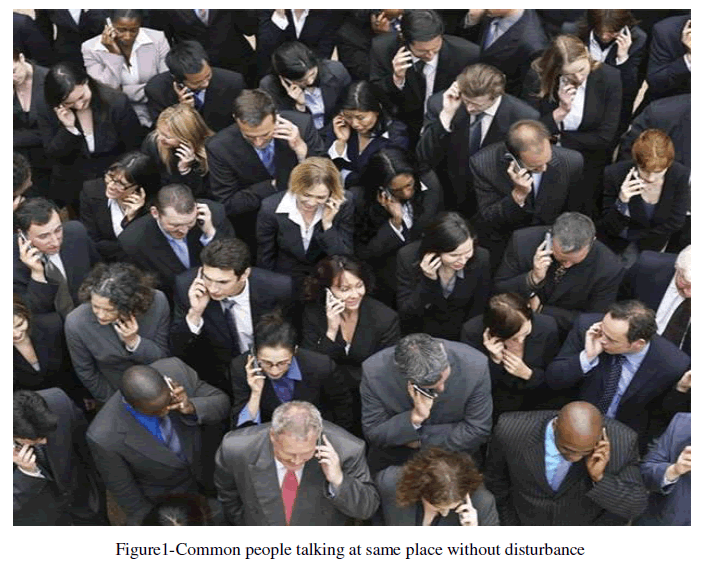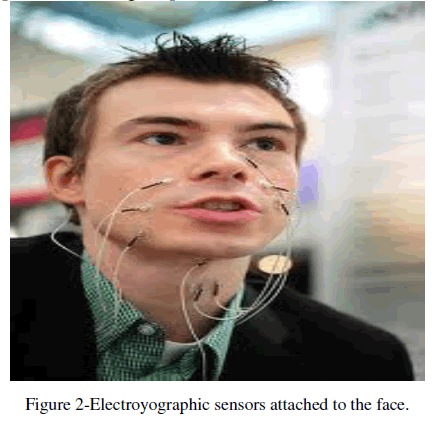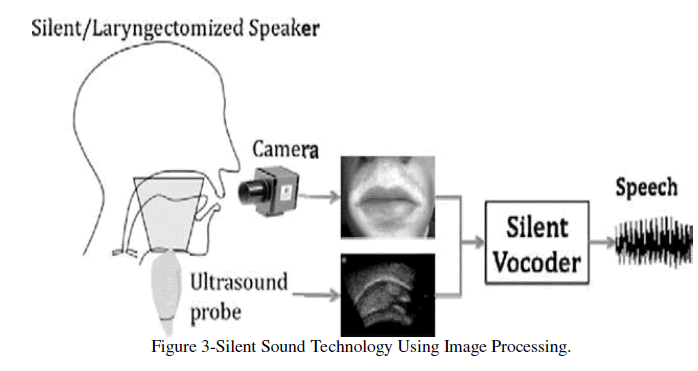ISSN ONLINE(2320-9801) PRINT (2320-9798)
ISSN ONLINE(2320-9801) PRINT (2320-9798)
Shehjar Safaya1, Kameshwar Sharma2
|
| Related article at Pubmed, Scholar Google |
Visit for more related articles at International Journal of Innovative Research in Computer and Communication Engineering
Nowadays whenever we are talking on a cell phone in a crowd, then actually we are not talking, we are yelling because of lots of disturbance and noise around us. However, there is no need to scream to convey our message and wasting our energy anymore.For this purpose a new technology known as the “Silent Sound Technology” has been introduced that will put an end to the noise pollution. The Silent sound technology is a perfect solution for those people who have lost their voice but wish to speak on mobile phones. It is developed at the Karlsruhe Institute of Technology and you can expect to see it in the near future. When this technology is used, it detects every lip movement and internally converts the electrical pulses into sounds signals and sends them neglecting all other surrounding noise. It is going to be really beneficial for the people who hate talking loudly on cell phones. “Silent Sound technology” aims to notice every movements of the lips and transform them into sounds, which could help people who lose voices to speak, and allow people to make silent calls without bothering others. Rather than making any sounds, your handset would decipher the movements your mouth makes by measuring muscle activity, then convert this into speech that the person on the other end of the call can hear. So, basically, it reads our lips. Another important benefit of this technology is that it allows you to communicate to any person in the world as the electrical pulse is universal, it can be converted into any language depending upon the users choice. This technology can be used for languages like English, French & German but not for languages like Chinese because different tones hold different meaning in Chinese language. This new technology will be very helpful whenever a person loses his voice while speaking or allow people to make silent calls without disturbing others, thus now we can speak anything with our friends or family in private without anyone eavesdropping. At the other end, the listener can hear a clear voice. This device works with 99% efficiency, and can been seen in the market in another 5-10 years and once launched it will have a drastic effect and with no doubt it will be widely used.
Keywords |
| Silent sound, image processing, electromyography, cell phone. |
INTRODUCTION |
| Silent Speech technology enables speech communication to take place when an audible acoustic signal is unavailable. By acquiring sensor data from elements of the human speech production process – from the articulators, their neural pathways, or the brain itself – it produces a digital representation of speech which can be synthesized directly, interpreted as data, or routed into a communications network.[1] |
| While improving aids for the speech-handicapped has been an objective of biomedical engineering for many years, the recent increase of interest in Silent Sound technology arises also from a second, quite different class of applications: providing privacy for cellular telephone conversations. It is widely agreed that cell phones can be an annoyance in meetings or quiet areas, and in many public places today their use is banned. Quite often the cell phone user, too, is uncomfortable having the content of his or her conversation become public. At the same time, the ability to field an urgent or important call at any location could in many instances be a very useful service. This technology, if noninvasive and small enough to be incorporated into a telephone handset, would resolve these issues by allowing users to communicate silently, without disturbing those around them. Given the numbers of cell phones in use today, the market for this technology could potentially become very important if such a concept gained public acceptance. |
| Silent Sound technology is a technology that helps you to transmit information without using your vocal cords. Silent Sound technology is developed at the Karlsruhe Institute of Technology, Germany. This technology uses electromyography. It monitors tiny muscular movements that occur when we speak and converting them into electrical pulses that can then be turned into speech, without a sound uttered. It is very useful for those people who can’t speak. By using this technology they can easily interact with the other persons. The benefit of this technology is that the listener can hear voice clearly. This technology aims to notice lip movements & transform them into a computer generated sound that can be transmitted over a phone. Hence person on other end of phone receive the information in audio. The idea of interpreting silent speech electronically or with a computer has been around for a long time, and was popularized in the 1968 Stanley Kubrick science-fiction film ‘‘2001-A Space Odyssey.”[3] |
| In the 2010 CeBIT's "future park", a concept "Silent Sound" Technology demonstrated which aims to notice every movement of the lips and transform them into sounds, which could help people who lose voices to speak, and allow people to make silent calls without bothering others.[4]Rather than making any sounds, your handset would decipher the movements your mouth makes by measuring muscle activity, then convert this into speech that the person on the other end of the call can hear. So, basically, it reads your lips. Thus people can talk on their cell phones at the crowded place without getting disturbed as show in Figure 1. |
 |
| “We currently use electrodes which are glued to the skin. In the future, such electrodes might for example by incorporated into cell phones,” said Michael Wand, from the KIT.[7]The technology opens up a host of applications, from helping people who have lost their voice due to illness or accident. The technology can also turn you into an instant polyglot. Because the electrical pulses are universal, they can be immediately transformed into the language of the user’s choice. “Native speakers can silently utter a sentence in their language, and the receivers hear the translated sentence in their language. It appears as if the native speaker produced speech in a foreign language,” said Wand. |
II. METHODS |
| Silent Sound Technology is processed through some ways or methods. They are: |
A. Electromyography (EMG) |
| The Silent Sound Technology uses electromyography, monitoring tiny muscular movements that occur when we speak. Electromyography (EMG) is a technique for evaluating and recording the electrical activity produced by skeletal muscles. EMG is performed using an instrument called an electromyograph, to produce a record called an electromyogram. An electromyograph detects the electrical potential generated by muscle cells when these cells are electrically or neurologically activated.[5]Monitored signals are converted into electrical pulses that can then be turned into speech, without a sound uttered. It is a technique which monitors tiny muscular movements and pulses generated by it. The transducers involved converts the pulses into electric signals. The electrical source is the muscle membrane potential of about -90 mV.[6] Measured EMG potentials range between less than 50 μV and up to 20 to 30 mV, depending on the muscle under observation. |
| As shown in Figure 2 the electromyography sensors attached to the face records the electric signals produced by the facial muscles, compare them with prerecorded signal pattern of spoken words. |
 |
| When there is a match that sound is transmitted on to the other end of the line and person at the other end listen to the spoken words.A needle containing two fine-wired electrodes is inserted through the skin into the muscle tissue. Normal muscles at rest make certain, normal electrical sounds when the needle is inserted into them. A trained professional (such as a neurologist, physiatrist, or physical therapist) observes the electrical activity while inserting the electrode. The insertional activity provides valuable information about the state of the muscle and its innervating nerve. Then the electrical activity when the muscle is at rest is observed. Each electrode track gives only a very local picture of the activity of the whole muscle. Because skeletal muscles differ in the inner structure, the electrode has to be placed at various locations to obtain an accurate signal. Thus by this way the speech can be communicated without sound. |
B. Image Processing |
| The simplest form of digital image processing converts the digital data tape into a film image with minimal corrections and calibrations. Then large mainframe computers are employed for sophisticated interactive manipulation of the data. In the present context, overhead prospective are employed to analyse the picture. In electrical engineering and computer science, image processing is any form of signal processing for which the input is an image, such as a photograph or video frame; the output of image processing may be either an image or, a set of characteristics or parameters related to the image. In the silent sound technology the output of this image processing is an audio record. Most image-processing techniques involve treating the image as a two-dimensional signal and applying standard signal-processing techniques to it. Figure 3 shows how image processing works in case of silent sound technology. |
 |
III. APPLICATIONS OF SILENT SOUND TECHNOLOGY |
| The Technology opens up a host of application such as mentioned below: |
| • As we know in space there is no medium for sound to travel therefore this technology can be best utilized by astronauts. |
| • Helping people who have lost their voice due to illness or accident. |
| • We can make silent calls even if we are standing in a crowded place. |
| • Allow people to make silent calls without bothering others. |
| • Telling a trusted friend your PIN number over the phone without anyone eavesdropping -assuming no lipreaders are around. |
| • Silent Sound Techniques is applied in Military for communicating secret/confidential matters to others. |
| • Since the electrical signals are universal they can be translated into any language. Native speakers can translate it before sending it to the other side. Hence it can be converted into any language of choice currently being German, English & French. |
IV. RESTRICTIONS |
| ï· Translation into majority of languages but for languages such as Chinese different tone holds different meaning, facial movements being the same. Hence this technology is difficult to apply in such situations. |
| ï· From security point of view recognizing who you are talking to gets complicated. |
| ï· Even differentiating between people and emotions cannot be done. This means you will always feel you are talking to a robot. |
| ï· This device presently needs nine leads to be attached to our face which is quite impractical to make it usable. |
V. RESEARCH AND FUTURE PROSPECT |
| ï· Silent sound technology gives way to a bright future to speech recognition technology from simple voice commands to memorandum dictated over the phone all this is fairly possible in noisy public places. |
| ï· Without having electrodes hanging all around your face, these electrodes will be incorporated into cell phones. |
| ï· It may have features like lip reading based on image recognition & processing rather than electromyography. |
| ï· Nano technology will be a mentionable step towards making the device handy. |
| With all of the millions of phones in circulation, there is great potential for increasing earnings by saving 'lost calls' - telephone calls that go unanswered or uninitiated because the user is in a situation in which he or she cannot speak - not just in business meetings, but everyday situations. According to research, these 'lost calls' are worth $20 billion per year worldwide. For the cellular operator, these are potential earnings that are currently being left on the table. When these 'lost calls' become answerable, and can be conducted without making a sound, there is a tremendous potential for increased profits. Now the research is going on technology that can be used in Office Environment too. |
VI. CONCLUSION |
| Silent Sound Technology, one of the recent trends in the field of information technology implements “Talking without Actually Talking”. Engineers claim that the device is working with 99 percent efficiency. It is difficult to compare SSI technologies directly in a meaningful way. Since many of the systems are still preliminary, it would not make sense, for example, to compare speech recognition scores or synthesis quality at this stage. |
| ‘Silent Sound’ technology aims to notice every movements of the lips and transform them into sounds, which could help people who lose voices to speak, and allow people to make silent calls without bothering others. Rather than making any sounds, your handset would decipher the movements your mouth makes by measuring muscle activity, then convert this into speech that the person on the other end of the call can hear. So, basically, it reads your lips. It will be one of the innovation and useful technology and in mere future this technology will be used in our day to day life. |
References |
|